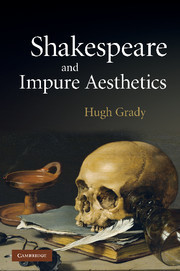Description
Shakespeare and Impure Aesthetics
Author: Grady Hugh
This book examines Shakespeare's plays and defines specific Shakespearean aesthetic practices in his use of desire, death and mourning.
Language: EnglishApproximative price 48.38 €
In Print (Delivery period: 14 days).
Add to cart
Shakespeare and Impure Aesthetics
Publication date: 04-2012
Support: Print on demand
Publication date: 04-2012
Support: Print on demand
Approximative price 104.26 €
Subject to availability at the publisher.
Add to cart
Shakespeare and impure aesthetics
Publication date: 08-2009
272 p. · 15.8x23.5 cm · Hardback
Publication date: 08-2009
272 p. · 15.8x23.5 cm · Hardback
Description
/li>Contents
/li>
Shakespeare and Impure Aesthetics explores ideas about art implicit in Shakespeare's plays and defines specific Shakespearean aesthetic practices in his use of desire, death and mourning as resources for art. Hugh Grady draws on a tradition of aesthetic theorists who understand art as always formed in a specific historical moment but as also distanced from its context through its form and Utopian projections. Grady sees A Midsummer Night's Dream, Timon of Athens, Hamlet, and Romeo and Juliet as displaying these qualities, showing aesthetic theory's usefulness for close readings of the plays. The book argues that such social-minded 'impure aesthetics' can revitalize the political impulses of the new historicism while opening up a new aesthetic dimension in the current discussion of Shakespeare.
Acknowledgements; 1. Introduction: impure aesthetics; Part I. A Shakespearean Aesthetic: Into the Woods outside Athens: 2. A Midsummer Night's Dream - eros and the aesthetic; 3. Modernity, usury, and art in Timon of Athens; Part II. The Aesthetics of Death and Mourning: 4. Hamlet as mourning play; 5. Beautiful death in Romeo and Juliet; Conclusion: the critical present; Bibliography; Index.
© 2024 LAVOISIER S.A.S.
These books may interest you

Shakespeare's Tragedies 53.83 €




